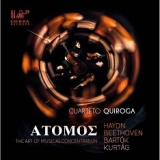Zu seinem zwanzigjährigen Bestehen legt das Cuarteto Quiroga eine persönliche Hommage an das Genre vor, die vielleicht das Dreigestirn, nämlich Haydn Beethoven und Bartok zeigt sowie Kurtag und eine Prise Webern. Secreta von Kurtag wurde erstmals eingespielt.
Haydn ist mit dem d-Moll Quartett op. 42 vertreten, einem alleinstehenden Werk. Hierfür hatte Haydn einen Auftrag aus Spanien, so dass es für das Cuarteto Quiroga nahelag, dieses Werk auszuwählen. In klassisch abgewogenem Spiel, mitunter mit sanftem Nachdruck, stellen sie dieses Stück dar. In dieser Komposition nähert sich Haydn schon deutlich dem Modell der gleichmäßigen Verteilung der Stimmanteile. Und das setzten die vier Musiker des Cuarteto Quiroga bestens um, wobei sie im ersten Satz die Wiederholung weggelassen haben.
Das Serioso-Quartett von Beethoven ist ein sehr ungeduldiges Werk mit heftigen Ausbrüchen. Das Allegro con brio, also als schnell und mit Feuer zu spielen, setzt das Quiroga Quartett wirbelnd um. Das verhaltene und auch ein wenig geheimnisvolle Allegretto machen sie mit einer verinnerlichten Deutung hörbar. Das anschließende Scherzo stellen sie mit markant abgehackten Rhythmus spannungsvoll dar und man hat kaum Zeit, es zu erleben. Dem Finalsatz geben sie wiederum viel Energie und Tempo mit, bis sie in der Coda den Buffo-Charakter prickelnd entkorken.
Im dritten Quartett von Bartok realisieren sie zugleich eine warme wie auch markante Lesart. Im Seconda parta führt das kurzfristig zu einer monoton klingenden Phrasierung. Die Recapitulazione wird dann wieder die wärmere Emphase hervorgeholt, bevor dann die Coda nach geheimnisvoll wisperndem Anfang ihre Energie entlädt.
Alle Quartette zeigen sich selbst und auch in den Interpretationen des Cuarteto Quiroga als Konzentrationen auf kleinste verdichtete Einheiten. Das wird auch in dem gehauchten Secreta von György Kurtág und der fünften Bagatelle von Anton Webern beibehalten. Man mag fragen, warum sie nur eine Bagatelle beigefügt haben und nicht alle sechs der kompromisslos verknappten Bagatellen. Zumal die CD mit knapp 60 Minuten Spielzeit noch den Platz geboten hätte.
Das 2003 gegründete Cuarteto Quiroga kann, wie in den Ecksätzen bei Beethoven, als eines der dynamischsten seiner Generation gehört werden. Unverwechselbar in ihrem Herangehen, die Werke fließend nach der Musik und doch auch mit gestaltendem Eingriff darzustellen, legen sie einen persönlichen Zugang zum Streichquartett-Repertoire.
On the occasion of its twentieth anniversary, Cuarteto Quiroga presents a personal homage to the genre, featuring perhaps the triumvirate Haydn Beethoven and Bartok, as well as Kurtag and a pinch of Webern. Secreta by Kurtag was recorded for the first time.
Haydn is represented by the D minor Quartet op. 42, a stand-alone work. For this Haydn had a commission from Spain, so it was natural for the Cuarteto Quiroga to choose this work. They present this piece in classically balanced playing, sometimes with gentle emphasis. In this composition Haydn already clearly approaches the model of the equal distribution of the voice parts. And the four musicians of the Cuarteto Quiroga implemented this in the best possible way, omitting the repetition in the first movement.
The Serioso Quartet shows Beethoven in a very impatient work with violent outbursts. The Quiroga Quartet plays the Allegro con brio, in a swirling manner. They make the restrained and also somewhat mysterious Allegretto audible with an interiorized interpretation. They present the following Scherzo with strikingly choppy rhythms full of tension and one hardly has time to experience it. They give the final movement again a lot of energy and tempo, until in the coda they sparklingly uncork the buffo character.
In Bartok’s third quartet they realize both a warm and striking reading. In the Seconda parta, this leads briefly to a monotonous-sounding phrasing. The Recapitulazione then brings out the warmer emphasis again, before the coda unloads its energy after a mysteriously whispering beginning.
All the quartets show themselves and also in the interpretations of the Cuarteto Quiroga as concentrations on the smallest condensed units. This is also maintained in the breathed Secreta by György Kurtag and the fifth Bagatelle by Anton Webern. One might ask why they included only one Bagatelle and not all six of the uncompromisingly condensed Bagatelles. Especially since the CD, with just under 60 minutes of playing time, would still have offered the space.
The Cuarteto Quiroga, founded in 2003, can be heard here as one of the most dynamic of its generation. Distinctive in their approach of presenting the works fluidly according to the music and yet also with formative intervention, they lay out a personal approach to the string quartet repertoire.
























